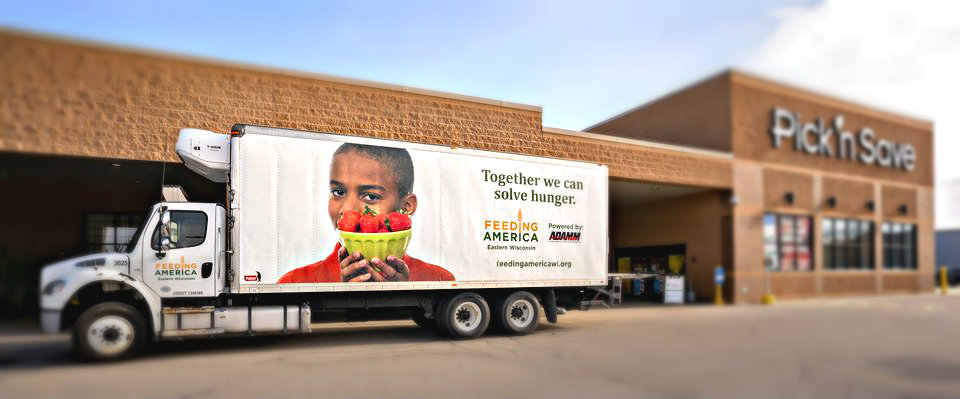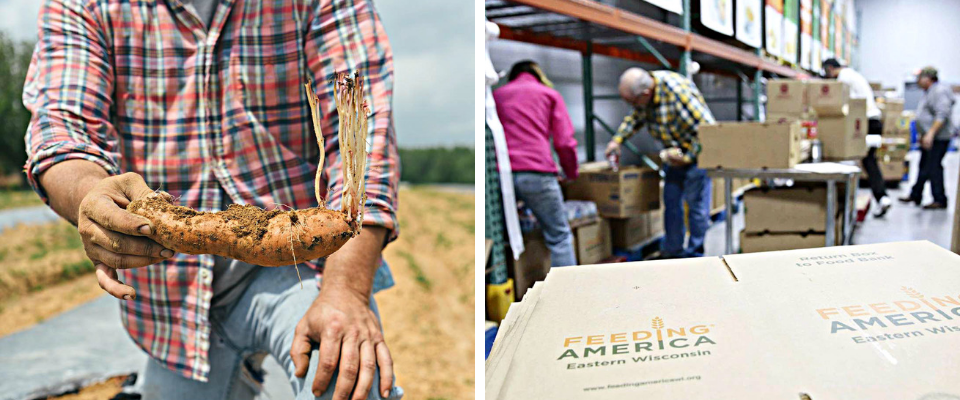In 2020, “food banks are facing a ‘perfect storm’ of surges in demand, declining food donations, fewer volunteers and disruptions to our operating procedures,” says Claire Babineaux-Fontenot, chief executive officer of Feeding America.
During the pandemic, people seeking help from the network’s food banks increased by an average of 50%. Cars filled huge parking lots to help community members safely get food and other household items from drive-thru pantries.
“Between March and June, roughly 4-in-10 people visiting food banks had not received food assistance before the pandemic,” according to the organization. “In fact, as we plan ahead, we expect there to be a supply gap of 8 billion meals needed to feed our neighbors.”
Feeding America continues bringing food and supplies to people uprooted by unemployment, disease, wildfires and hurricanes. However, shortages, new restrictions and spending disruptions further strained an already broken food supply chain.
A Broken Food Chain
“While we’re a very prosperous nation, there is a lot of need in this country,” says Steve Carlberg, managing director of infrastructure and security for Feeding America. One constant, grave need in America: food.
Hunger in the U.S. is a perplexing problem, given that Americans trash billions of pounds of food per year. Almost three-quarters of U.S. food waste comes from manufacturers, grocery stores and restaurants. Over a quarter of food waste happens on farms. “The volume of what we waste is mind-boggling, and it really can help us feed everyone in need in America,” says Lisa Jericho, former vice president of IT for Feeding America.
The obvious solution is to reroute food from landfills to hungry people. Distributing food to the people most in need—for example, where bananas are in short supply and won’t rot on shelves—is not so easy.
Feeding America, a U.S. hunger relief organization, adopts modern solutions to rescue food and respond faster to hunger. Mobile and cloud technologies bolster the national food distribution network with lighter weight operations, agility and greater visibility into the food distribution chain.
“It’s a powerful thing when you realize that produce would go to waste if it hadn’t made it through the supply chain, which happens all the time,” says Jericho. “We’re looking at new ways to use technology to rescue more food, to help more people and to distribute more nutritious food.”
Mobilizing Fresh Foods

Food banks tend to stock up on long-lasting canned foods, but rescuing fresh, whole foods is a strategic priority for Feeding America. “When people eat better, their entire life gets better,” says Jericho. “We want to show the people we serve the dignity to allow them food choice. We also know that more nutritious food is better for their family and their future.”
Often, the fresh foods Feeding America rescues are nearing expiration of an already short shelf life. Food must be transported, sorted and distributed in the fewest moves, to not waste money and beat food expiration dates.
Many factors impact this complex food distribution process, like the remaining shelf life and transportation costs and time. Feeding America also must consider the storage requirements of specific foods, available facilities and regional demand. Naturally, technology plays a key role in identifying the smartest moves.
“Our Produce Matchmaker application, for example, lets us match produce supply with the demand at the food bank based on their need,” explains Jericho. “Food banks log in online or through the mobile app to see what’s available and determine the best match for their community’s needs. They’re also able to arrange transportation, which in produce obviously is very time-sensitive. Members can be out working with local farmers or local grocery stores and yet still be able to source newly available produce in that moment, no matter where they’re at."
“MealConnect is one of our other mobile-enabled platforms, which matches demand at places like Starbucks or your local grocery store to ensure that food is picked up by both food banks and agencies and brought to the people they’re serving the next day,” she adds. Feeding America estimated the technology platform could aid in the rescue of another 740 million meals each year. Since the inception of the app, businesses and partners rescued more than 1 billion pounds of food with MealConnect.
In response to the pandemic, Feeding America updated and scaled the MealConnect platform across the country. This effort is “making MealConnect the only food rescue technology available nationwide.” Now, more types of businesses can donate unsold product to any of the 200 food banks in the Feeding America network.
“We analyzed traffic patterns on mealconnect.org and reconfigured it to ease access to higher-demand areas of the website, like posting a donation,” Justin Block, managing director of digital platform technology for Feeding America, tells Waste360. “We also restructured the account creation process, so now a business can simply post a donation and wait for pickup confirmation rather than create an account and wait for approval prior to donating.”
And with 17 million more projected to be at risk of hunger by the end of the summer due to COVID-19, making MealConnect available in every community is critical.
ARYANN BYRDAK, CIO, FEEDING AMERICA
Racing against Expiration Dates
Feeding America’s fresh food donations come from a variety of sources, from stores and farms with regular pickup days or one-time donations from businesses. The biggest challenge isn’t finding food. It’s getting the food to the right place at the right time. Logistics and transportation, alone, eat up scarce resources and time.
“The thing is, we do have enough food. It’s logistical issues that get in the way of getting the food from the producers and the wholesalers to the people that could use it,” says Scott Marshall, vice president of development and communications for Feeding America Eastern Wisconsin (FAEW). “That’s our role, and technology is involved in every piece of that.”
“I can’t tell you how often someone calls us with a surplus of beautiful produce, but it’s across the country. The food is free, but getting it here will cost thousands of dollars. We have to determine the value of the food and how quickly we’ll be able to turn it around to our members,” says Marshall. “That’s where technology comes into play, identifying how long we’re able to have that produce on hand and how fast we’re able to get it to a member, so that they can get it to someone to eat it for dinner that night.”
Through Feeding America’s digitally connected network, FAEW can reroute a truck already on the road to a new location and ensure a member is ready to receive the inventory. Food banks also arrange swaps of surplus foods to offer a greater variety to each of their regions. “We could connect with a food bank in Georgia, for example, to trade apples for peaches or milk for peanut butter,” says Marshall. “Then, both locations are able to provide a more varied and healthier menu for the people that they serve.”
Tracing Farm-to-Warehouse Food

Once food arrives at a member food bank, it’s sorted into dry, refrigerated and frozen foods for storage. Before that, most importantly, food is recorded with inventory software and assigned a donor receipt number that follows products through sorting and distribution. “Our inventory software tracks it from the moment we get it into our building until the time it leaves,” says Rick Perkins, director of operations for FAEW.
Barcodes help warehouse staff quickly find non-perishable items that members order online, foods to load on trucks and perishable items that members “shop” for in person. “We typically try to move things pretty fast,” says Perkins. “Without tracking technology, we’d never be able to efficiently trace what we have for timely sorting and distribution. We probably wouldn’t be able to get out a quarter of the millions of pounds of food we provide a year.”
FAEW has a number of places to track food between an 88,000-square-foot warehouse in Milwaukee, a 40,000-square-foot food bank in the Fox Valley and hundreds of food pantries and meal programs throughout the state. “With technology, we know where that food is and where it’s going,” he says. “It’s going to feed the people that actually need it most in the areas of Wisconsin we serve.”
Feeding the Tech Food Chain
Feeding America food banks depend on technology for day-to-day operations. It’s how food is tracked going in and out of warehouses. It’s how trucks are routed. Without highly available technology, food banks could “go out of business,” says Carlberg.
However, each food bank employs a limited workforce, mostly for business and warehouse operation. According to Carlberg: “They don’t have a lot of technical staff, nor should they. They focus on getting food to their community.”
His team offers technical support, so members can focus on their core mission. That support previously included maintaining the hardware of about 360 servers for 50 locations. Now, he enlists the help of cloud provider managed services with Rackspace, a VMware Cloud Provider, to to oversee physical infrastructure–shifting his team’s focus to their core mission–and to ensure ongoing availability of mission-critical technologies.
“Before transitioning to managed cloud services, we owned and maintained all the hardware. In some regards, that took away from our core mission,” he says. “I worried about the health of the physical infrastructure instead of whether we’re running the right applications to meet business needs. Now the vendor manages all that, and I get to tap into many new cloud specialists to help us be better and respond quicker to problems.”
Instead of replacing servers, Carlberg now oversees and manages workloads across the country from his desk. A monitoring tool visualizes the overall health of IT environments for all locations that Feeding America supports.
Each food bank is represented on a map by a color-coded dot with a three-letter site code: green if all is good or red if warnings or critical issues are identified. When locations appear in red, he hovers over the site for detailed data on capacity, systems, health, recent history, uptime, performance and more. Carlberg checks this daily for “fires” he needs to quickly put out, like unplanned outages, and to assess where resources should go.
“What we’re able to now do is become more adaptable to changing business needs,” says Jericho. “In the past we couldn’t respond to performance issues. We couldn’t rapidly spin up new environments for testing. We couldn’t effectively help manage projects. In the cloud, we ensure performance is always at its peak, and it takes a lot less resources from my team.”
Most importantly, operating in the cloud helps ensure food doesn’t go to waste. “The worst-case scenario would be that we weren’t able to move food to the proper destination in time. System downtime prohibits us from accomplishing that,” says Jericho. “When food banks order products and book transportation, they rely on getting the food on time. Utilizing cloud computing, we have higher uptime, more system reliability and better system performance to keep the supply chain moving.”
… No food bank has shuttered as a result of the pandemic. Only 8% of food banks report concern over potentially running out of food and ceasing operations in the next two to four weeks.
"FEEDING AMERICA NETWORK STAYS RESILIENT DURING COVID-19 CRISIS," PUBLISHED 2020, BY FEEDING AMERICA
Operating in Disaster Mode
Natural disasters, outbreaks and other unpredictable events demand even more critical decision-making and urgency to move generous spikes in food donations to places with unexpected food shortages.
Feeding America prepares for predictable disasters, like hurricane season, by packaging bottled water and other supplies in advance and staging donations through their supply chain solutions. “In those moments, communication, email, productivity and being able to keep the supply chain up and running become critical,” says Jericho. “We don’t have time for delays. We don’t have time for the resources to get relocated to the right places at the time.”
Of course, not every natural disaster can be predicted.
“Last year we had to face the disaster in both Florida and Puerto Rico. It’s very unusual for us to have such a sustained length of time where we’re in disaster mode,” recalls Jericho. “Of course, it’s an island, so it brought a lot of new components into the supply chain. Yet, we were able to adapt rapidly and make all of that come together to be able to provide food to those in need in Puerto Rico.”
“We work very well as a network together,” says Perkins. “When hurricanes came through Puerto Rico last year, we were able to send truckloads of canned goods down to them. We were able to do that in a couple hours, and it was on its way to them because of the technology behind it.”
Part of our strategy in the future is to have a data-driven ecosystem and have that data centralized, so we can gain insights immediately on where our demand is and respond to it appropriately.
MARYANN BYRDAK, CIO, FEEDING AMERICA
Putting Money Where Mouths Are
Feeding America ensures every dollar donated to the organization produces 10 meals. Excessive spending could literally take food off the table of the people they serve.
“We take stewardship of donated dollars very seriously at Feeding America,” says Jericho. “We partner with industry-leading technology providers, who enable my team and I to grow our skills, stay on the cutting edge and still be mindful of dollars spent and how we’re providing business value to the organization.”
Technology empowers IT to direct as many resources as possible toward food sustainability. “I can put more money towards the core mission rather than supporting infrastructure,” says Carlberg. “Also, most of what we do today can be done remotely and efficiently, so there’s no need to spend money on travel that could be going to feed people.”
“For any nonprofit, efficiency is key. And technology is a huge part of that efficiency,” says Marshall.

